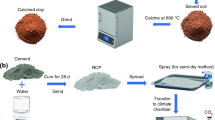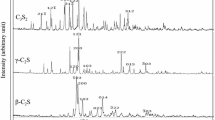Abstract
One of the main issues in the field of Monument Protection is the degradation of limestones as a result of the action of various weathering mechanisms. The modification of widely used silicon-based materials for stone consolidation is intended to overcome the well-known drawbacks of these materials, such as shrinkage and cracking tendency during drying. The addition of nano-dispersions into a silica matrix aims to enhance their effectiveness in several ways, by improving their properties and their viscoelastic behavior. The objective of the current research was the application and evaluation of Si-based modified nanocomposites of optimized composition. The materials were applied to two types of porous stone and the assessment of their compatibility and performance was carried out by using both laboratory techniques and methods (SEM, MIP, TMA, Water Absorption by Capillarity, determination of Water Vapor Permeability) and non-destructive techniques (Ultrasound Velocity determination, Colorimetry). To study the resistance of the treated samples to soluble salt crystallization, accelerated aging tests were performed in sodium sulfate cycles. The modified consolidants consist of an ethyl silicate matrix reinforced with colloidal silica (SiO2) nano-particles and titania (TiO2) particles. Based on the results, the consolidating material does not significantly alter the characteristics of the microstructure and the appearance of stones, allowing the passage of water vapor, while increasing their mechanical properties. Furthermore, the accelerated ageing tests revealed that the treated samples have a higher resistance to the action and crystallization of soluble salts in comparison to untreated.














Similar content being viewed by others
References
Verges-Belmin V et al (2008) Illustrated glossary on stone deterioration patterns, Monuments and Sites. XV. ICOMOS International Scientific Committee for Stone (ISCS), Paris
Steiger M, Charola AE, Sterflinger K (2011) Weathering and Deterioration. In: Siegesmund S, Snethlage R (eds) Stone in Architecture. Springer, Berlin, pp 227–316
Sassoni E, Graziani G, Franzoni E (2016) An innovative phosphate-based consolidant for limestone. Part 2: durability in comparison with ethyl silicate. Constr Build Mater 102:931–942
Ruedrich J, Siegesmund S (2007) Salt and ice crystallisation in porous sandstones. Environ Geol 52:225–249
Moropoulou A, Haralampopoulos G, Tsiourva T, Auger F, Birginie JM (2003) Artificial weathering and non-destructive tests for the performance evaluation of consolidation materials applied on porous stones. Mater Struct 36(4):210–217
Ferreira Pinto P, Delgado Rodriques J (2008) Stone Consolidation: the role of treatment Procedures. J Cult Herit 9:38–53
Franzoni E, Graziani G, Sassoni E, Bacilieri G, Griffa M, Lura P (2015) Solvent-based ethyl silicate for stone consolidation: influence of the application technique on penetration depth, efficacy and pore occlusion. Mater Struct 48(11):3503–3515
Ksinopoulou E, Bakolas A, Moropoulou A (2016) Modifying Si-based consolidants through the addition of colloidal nanoparticles. Appl Phys A 122(4):1–10
ASTM E2167-01 (2008) Standard guide for selection and use of stone consolidants. ASTM International, West Conshohocken
Normal 20/85 (1985) Conservazione dei materiali lapidei: Manutenzione ordinaria e straordinaria. Istituto Centrale per il Restauro (ICR), Rome
Snethlage R, Sterflinger K (2011) Stone conservation. In: Siegesmund S, Snethlage R (eds) Stone in architecture. Springer, Berlin, pp 477–478
Laurenzi-Tabasso Μ, Simon S (2006) Testing methods and criteria for the selection/evaluation of products for the conservation of porous building materials. Rev Conserv 7:67–82
Delgado Rodrigues J, Grossi A (2007) Indicators and ratings for the compatibility assessment of conservation actions. J Cult Herit 8:32–43
Commission 25-PEM Protection et Erosion des Monuments (1980) Recommended tests to measure the deterioration of stone and to assess the effectiveness of treatment methods. Mater Struct 13:175–253
Delgado-Rodriguez J (2001) Consolidation of decayed stones. A delicate problem with few practical solutions. In: Lourenço PB, Roca P (eds) Historical constructions. University of Minho, Guimarães, pp 3–14
Price CA, Doehne E (2010) Stone conservation an overview of current research. The Getty Conservation Institute, Los Angeles
Scherer GW, Wheeler GS (2009) Silicate consolidants for stone. Key Eng Mater 391:1–25
Horrie CV (1999) Materials for conservation: organic consolidants, adhesives and Coatings. Butterworth-Heinemann, Oxford
Clifton JR (1980) Stone consolidating materials: a status report. National Bureau of Standards, Washington
Wheeler G (2005) Alkoxysilanes and the Consolidation of Stone. Getty Conservation Institute, Los Angeles
Zárraga R, Cervantes J, Salazar-Hernandez C, Wheeler G (2010) Effect of the addition of hydroxyl terminated polydimethylsiloxane to TEOS-based stone consolidants. J Cult Herit 11:138–144
Boos M, Grobe J, Hilbert G, Müller-Rochholz, J (1996) Modified elastic silicic acid ester applied on natural stone and tests of their efficiency. In Proceedings of the 8th international congress on deterioration and conservation of stone, pp 1179–1185. Berlin
Kim EK, Won J, Kim JJ, Kang YS, Kim SD (2008) TEOS/GPTMS/silica nanoparticle solutions for conservation of Korean heritage stones. In Proceedings of the 11th international congress on deterioration and conservation of stone, pp 915–923. Poland
Maravelaki-Kalaitzaki P, Kallithrakas-Kontos N, Agioutantis Z, Maurigiannakis S, Korakaki D (2008) A comparative study of porous limestones treated with silicon-based strengthening agents. Progress Org Coat 62(1):49–60
Mosquera MJ, de los Santos DM, Montes A (2005) Producing New Stone Consolidants for the Conservation of Monumental Stones. Mater. Res Soc Symp Proc, vol 852. Materials Research Society
Miliani C, Velo-Simpson ML, Scherer GW (2007) Particle-modified consolidants: a study on the effect of particles on sol–gel properties and consolidation effectiveness. J Cult Herit 8:1–6
Ksinopoulou E, Bakolas A, Kartsonakis IA, Charitidis CA, Moropoulou A (2012) Particle modified consolidants in the consolidation of porous stones In: Proceedings of 12th international congress on the deterioration and conservation of stone, Columbia University, New York
Mosquera MJ, de los Santos DM, Montes A, Valdez-Castro L (2008) New nanomaterials for consolidating stone. Langmuir 24:2772–2778
Liu R, Han X, Huang X, Li W, Luo H (2013) Preparation of three component TEOS-based composites for stone conservation by sol-gel process. J Sol Gel Sci Technol 68:19–30
Kapridaki C, Maravelaki NP (2015) TiO2–SiO2–PDMS nanocomposites with self-cleaning properties for stone protection and consolidation. Geol Soc Lond Spec Publ 416:SP416-6
Ksinopoulou E, Bakolas A, Moropoulou A (2014) Modification of Si-based consolidants by the addition of colloidal nanoparticles: application in porous stones. J Nano Res 27:143–152
Kapridaki C, Pinho L, Mosquera MJ, Maravelaki-Kalaitzaki P (2014) Producing photoactive, transparent and hydrophobic SiO2-crystalline TiO2 nanocomposites at ambient conditions with application as self-cleaning coatings. Appl Catal B 156:416–427
Stober W, Fink A (1968) Controlled growth of monodisperse silica spheres in the micron size range. J Colloid Interface Sci 26:62–69
Franzoni E, Sassoni E, Graziani G (2015) Brushing, poultice or immersion? The role of the application technique on the performance of a novel hydroxyapatite-based consolidating treatment for limestone. J Cult Herit 16(2):173–184
Leroux L, Verges-Belmin V, Costa D, Delgado Rodrigues J, Tiano P, Snethlage R, Singer B, Massey S, De Wi E (2000) Measur.ing the penetration depth of consolidating products: Comparison of six methods. In: Proceedings of the IX international congress on the deterioration and conservation of stone, vol 2, pp 361–370. Venice
Lopez-Arce P, Gomez-Villalba LS, Pinho L, Fernandez-Valle ME, Alvarez de Buergo M, Fort R (2010) Influence of porosity and relative humidity on consolidation of dolostone with calcium hydroxide nanoparticles: effectiveness assessment with non-destructive techniques. Mater Charact 61:168–184
Skoulikidis T, Vassiliou P, Tsakona K (2005) Surface consolidation of pentelic marble—criteria for the selection of methods and materials—the acropolis case. Environ Sci Pollut Res 12:28–33
Moropoulou A, Kouloumbi N, Haralampopoulos G, Konstanti A, Michailidis P (2003) Criteria and methodology for the evaluation of conservation interventions on treated porous stone susceptible to salt decay. Progress Org Coat 48:259–270
EN 15886 (2010) Conservation of cultural property. Test methods. Colour measurement of surfaces
EN 15801 (2010) Conservation of cultural property—Test methods-determination of water absorption by capillarity
ASTM E96 / E96M-16 (2016) Standard test methods for water vapor transmission of materials. ASTM International, West Conshohocken
Siegesmund S, Ullemeyer K, Weiss T, Tschegg EK (2000) Physical weathering of marbles caused by anisotropic thermal expansion. Int J Earth Sci 89:170–182
ASTM D2845-08 (2008) Standard test method for laboratory determination of pulse velocities and ultrasonic elastic constants of rock. ASTM International, West Conshohocken
ASTM E831-05 (2005) Standard test method for linear thermal expansion of solid materials by thermomechanical analysis. ASTM International, West Conshohocken
DIN 52111-03 (1990) Testing of natural stone and mineral aggregates; crystallization test with sodium sulfate
Graziani G, Sassoni E, Franzoni E (2015) Consolidation of porous carbonate stones by an innovative phosphate treatment: mechanical strengthening and physical-microstructural compatibility in comparison with TEOS-based treatments. Heritage Science 3(1):1
Franzoni E, Graziani G, Sassoni E (2015) TEOS-based treatments for stone consolidation: acceleration of hydrolysis–condensation reactions by poulticing. J Sol-Gel Sci Technol 74(2):398–405
Sassoni E, Franzoni E, Graziani G, Sagripanti F (2014) Limestone resistance to sodium sulfate degradation after consolidation by hydroxyapatite and TEOS. In Proceedings of the international conference on salt weathering of buildings and stone sculptures (SWBSS 2014), Aedificatio Publishers, Brussels (335-345)
Acknowledgements
This research has been co-financed by the European Union (European Social Fund—ESF) and Greek national funds through the Operational Program “Education and Lifelong Learning” of the National Strategic Reference Framework (NSRF)—Research Funding Program: Heracleitus II. Investing in knowledge society through the European Social Fund.
Author information
Authors and Affiliations
Corresponding author
Ethics declarations
Conflict of interest
The authors declare that they have no conflict of interest.
Rights and permissions
About this article
Cite this article
Ksinopoulou, E., Bakolas, A. & Moropoulou, A. Consolidation effectiveness of modified Si-based nanocomposites applied to limestones. Mater Struct 51, 156 (2018). https://doi.org/10.1617/s11527-018-1281-1
Received:
Accepted:
Published:
DOI: https://doi.org/10.1617/s11527-018-1281-1




